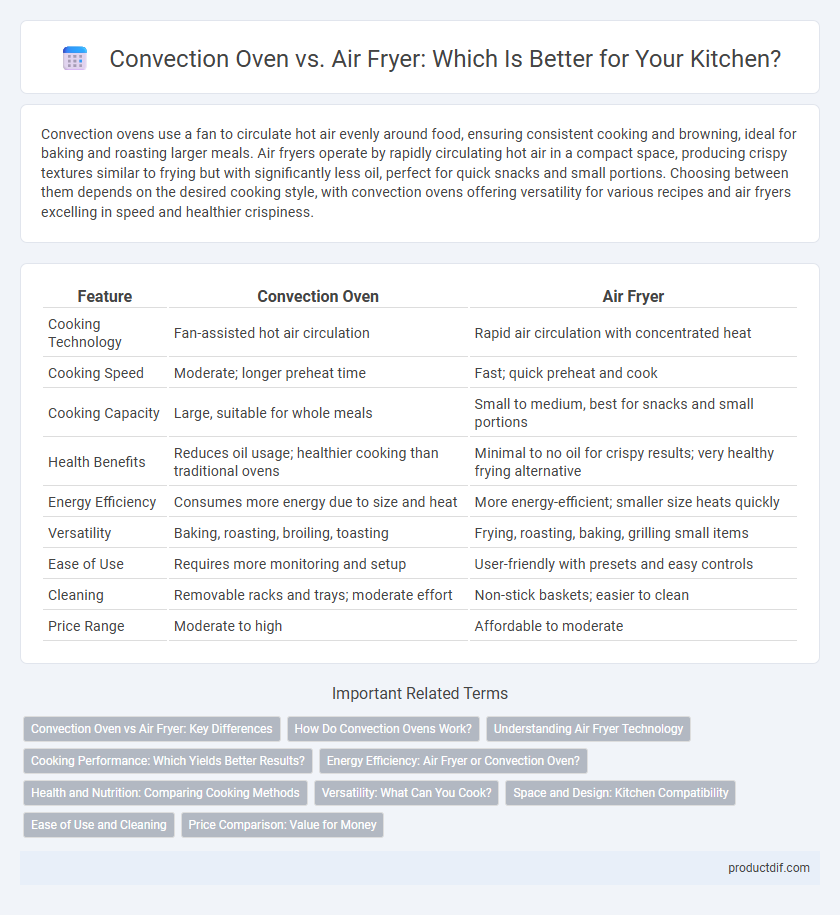Convection ovens use a fan to circulate hot air evenly around food, ensuring consistent cooking and browning, ideal for baking and roasting larger meals. Air fryers operate by rapidly circulating hot air in a compact space, producing crispy textures similar to frying but with significantly less oil, perfect for quick snacks and small portions. Choosing between them depends on the desired cooking style, with convection ovens offering versatility for various recipes and air fryers excelling in speed and healthier crispiness.
Table of Comparison
| Feature | Convection Oven | Air Fryer |
|---|---|---|
| Cooking Technology | Fan-assisted hot air circulation | Rapid air circulation with concentrated heat |
| Cooking Speed | Moderate; longer preheat time | Fast; quick preheat and cook |
| Cooking Capacity | Large, suitable for whole meals | Small to medium, best for snacks and small portions |
| Health Benefits | Reduces oil usage; healthier cooking than traditional ovens | Minimal to no oil for crispy results; very healthy frying alternative |
| Energy Efficiency | Consumes more energy due to size and heat | More energy-efficient; smaller size heats quickly |
| Versatility | Baking, roasting, broiling, toasting | Frying, roasting, baking, grilling small items |
| Ease of Use | Requires more monitoring and setup | User-friendly with presets and easy controls |
| Cleaning | Removable racks and trays; moderate effort | Non-stick baskets; easier to clean |
| Price Range | Moderate to high | Affordable to moderate |
Convection Oven vs Air Fryer: Key Differences
Convection ovens use a fan to circulate hot air evenly, allowing for consistent cooking and baking of larger quantities, while air fryers focus on rapid air circulation in a compact space for faster, crispier results with less oil. Temperature control in convection ovens typically ranges from 150 to 500 degrees Fahrenheit, suitable for roasting and baking, whereas air fryers often operate between 180 to 400 degrees Fahrenheit, optimized for frying and reheating. Size and cooking capacity differ significantly; convection ovens accommodate multiple dishes simultaneously, whereas air fryers are ideal for smaller portions and quick meals.
How Do Convection Ovens Work?
Convection ovens use a built-in fan and exhaust system to circulate hot air evenly around the food, promoting faster and more uniform cooking. This efficient airflow reduces cooking times and helps achieve a crispy exterior while retaining moisture inside. Unlike traditional ovens, convection ovens maintain consistent temperatures, enhancing baking, roasting, and broiling performance.
Understanding Air Fryer Technology
Air fryer technology utilizes rapid air circulation combined with a heating element to cook food quickly and evenly, mimicking the effects of deep frying but with significantly less oil. In contrast to convection ovens, air fryers feature a compact design that intensifies the airflow, resulting in faster crisping and more efficient heat distribution. This technology enables healthier cooking by reducing fat content while maintaining texture and flavor similar to traditional frying methods.
Cooking Performance: Which Yields Better Results?
Convection ovens provide even heat distribution through a fan, ensuring consistent cooking and browning, ideal for larger meals and baking. Air fryers use rapid air circulation to deliver crisp, fried-like textures with less oil, excelling in quick, small-batch cooking and healthier results. Choosing between them depends on the desired cooking style, but convection ovens offer superior versatility while air fryers specialize in speed and texture.
Energy Efficiency: Air Fryer or Convection Oven?
Air fryers generally consume less energy than convection ovens due to their smaller size and faster cooking times, making them more energy-efficient for quick meals. Convection ovens use a larger heating element and fan to circulate hot air, which can lead to higher energy consumption during longer cooking processes. For energy-conscious users, choosing an air fryer can significantly reduce electricity usage while still delivering crispy, evenly cooked food.
Health and Nutrition: Comparing Cooking Methods
Convection ovens circulate hot air for even cooking, preserving nutrients by reducing cooking time and minimizing oil use, which supports healthier eating. Air fryers use rapid air technology to achieve crispy textures with minimal oil, significantly lowering fat content compared to deep frying. Both methods enhance the retention of vitamins and antioxidants, making them superior choices for health-conscious meal preparation.
Versatility: What Can You Cook?
Convection ovens offer greater versatility by allowing you to bake, roast, broil, and even dehydrate a wide variety of foods, making them suitable for complex recipes and larger meal preparations. Air fryers specialize in quickly cooking crispy, fried-style dishes with less oil, excelling at items like fries, chicken wings, and small roasted vegetables, but they have limited capacity for bulk or multi-dish cooking. Both appliances enhance cooking efficiency, but convection ovens support a broader range of culinary techniques and larger volumes.
Space and Design: Kitchen Compatibility
Convection ovens typically require more countertop or built-in space, making them better suited for larger kitchens with ample room. Air fryers offer a compact, sleek design that fits easily into small kitchens or limited countertop areas without sacrificing functionality. Both appliances complement modern kitchen aesthetics but differ significantly in their spatial footprint and installation flexibility.
Ease of Use and Cleaning
Convection ovens offer intuitive controls and spacious interiors for easy meal preparation but often require more time and effort to clean due to larger surfaces and removable racks. Air fryers feature compact designs with simple digital interfaces, making them extremely user-friendly and convenient for quick cooking tasks. Their non-stick baskets and detachable parts are dishwasher-safe, significantly reducing cleaning time compared to convection ovens.
Price Comparison: Value for Money
Convection ovens typically range from $100 to $500 depending on size and brand, offering versatile cooking options for the price. Air fryers generally cost between $50 and $250, providing efficient, fast cooking with less oil consumption. For value, convection ovens provide multifunctionality, while air fryers appeal with affordability and convenience for quick meals.
Convection oven vs air fryer Infographic

 productdif.com
productdif.com